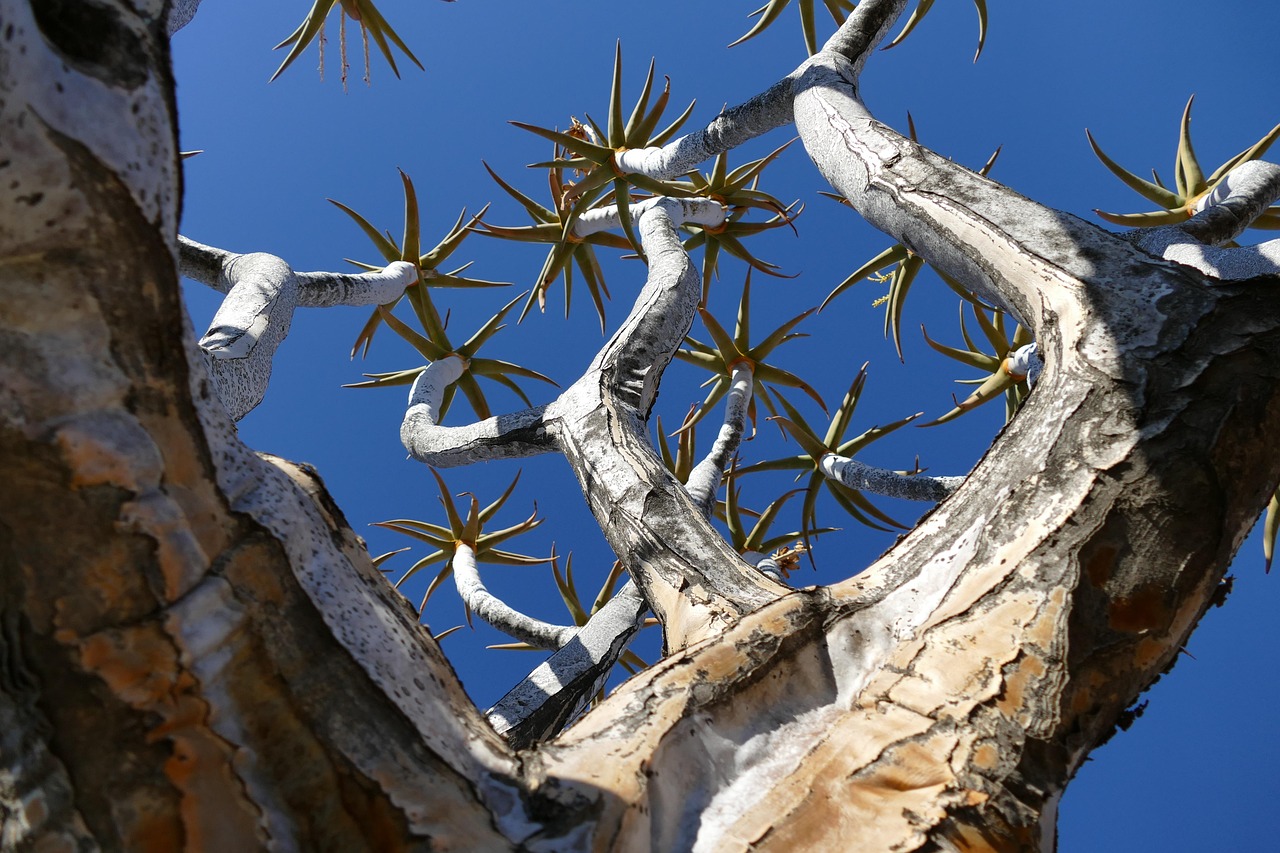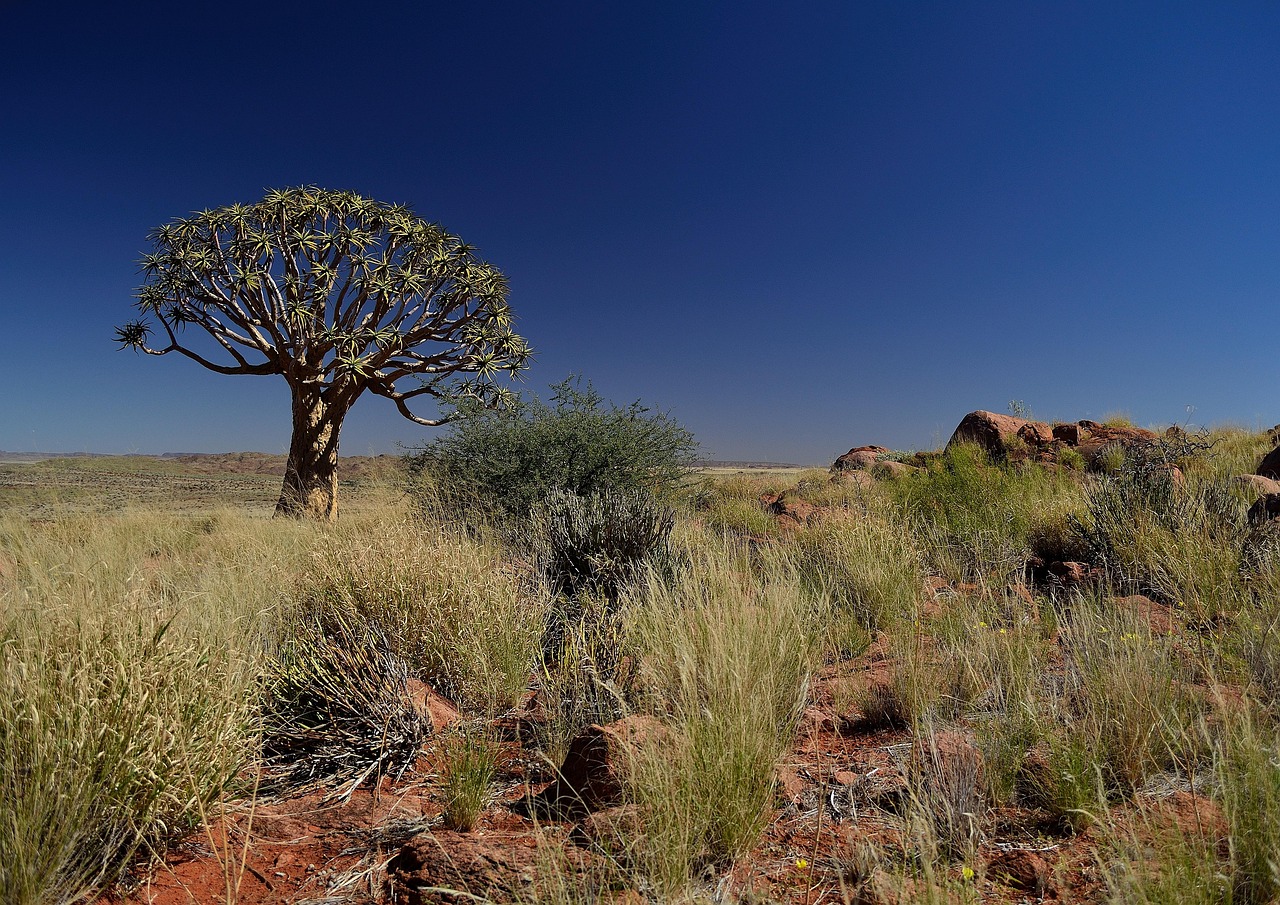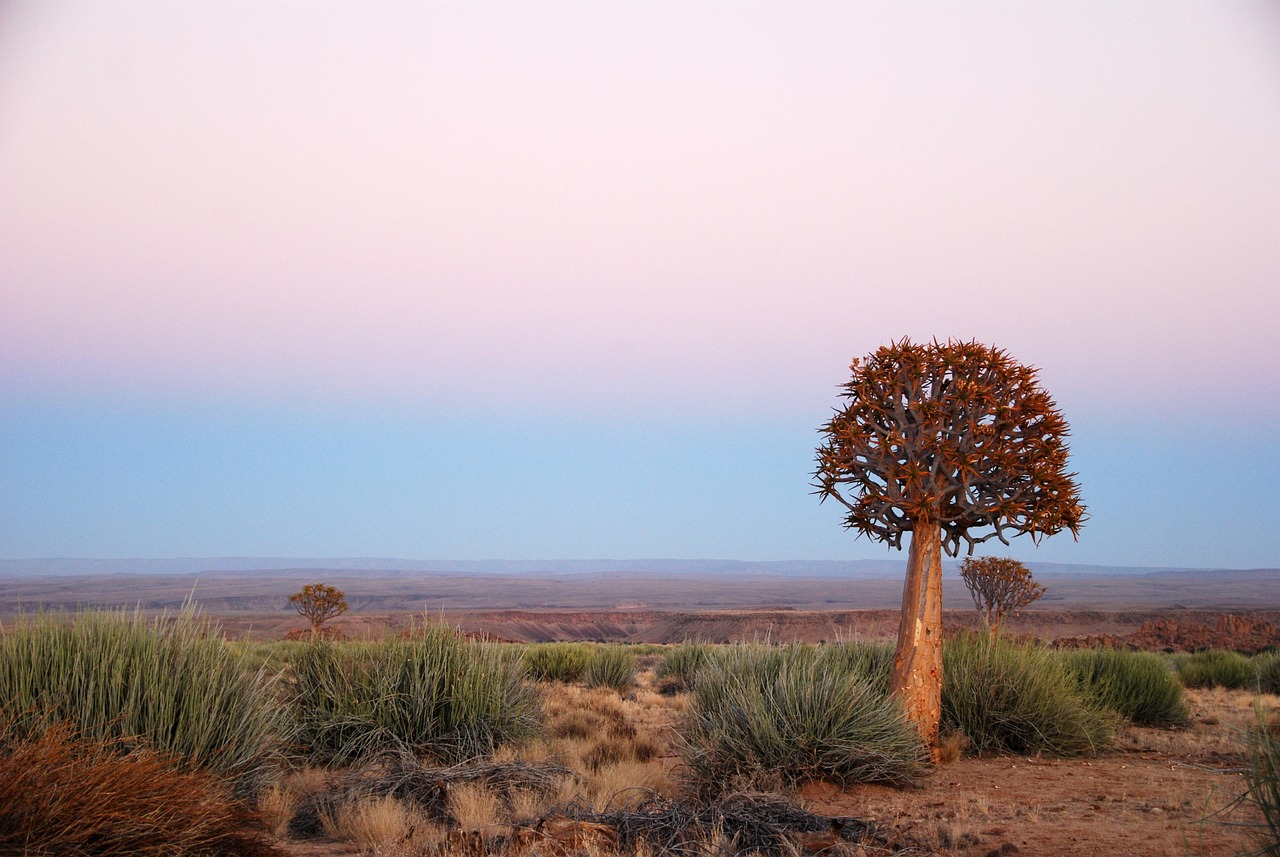The Quiver Tree, or Aloe dichotoma, has a moderate growth rate, typically reaching heights of 6 to 10 feet over 10 to 15 years under optimal conditions. With proper care, including adequate sunlight and well-draining soil, these unique succulents can thrive beautifully in gardens.
Understanding Quiver Trees
Quiver Trees are not actually trees but rather large, striking succulents native to Southern Africa. They are known for their distinctive branches and beautiful yellow flowers that bloom in the spring. Their unique appearance makes them popular in succulent gardens and landscapes, especially in arid regions.

These plants are particularly well-adapted to their native environments, where they endure harsh conditions including extreme temperatures and low rainfall. This resilience contributes to their appeal among gardeners who appreciate low-maintenance plants that provide significant visual interest.
Growth Rate Overview
The growth rate of Quiver Trees varies depending on several factors. These include environmental conditions, soil quality, and the care provided by the gardener. In ideal conditions, Quiver Trees can grow several inches each year. However, growth may slow down during colder months or in less than optimal environments.
Here are some key factors that influence the growth rate of Quiver Trees:

- Sunlight: Quiver Trees thrive in full sunlight. They require at least 6 hours of direct sunlight daily for optimal growth.
- Soil Type: Well-draining soil is crucial. Sandy or rocky soils are ideal as they prevent root rot.
- Watering: These succulents prefer infrequent watering. Overwatering can hinder growth and damage the plant.
- Temperature: They flourish in warm climates. Ideal temperatures range from 70°F to 80°F (21°C to 27°C).
Growth Stages of Quiver Trees
Quiver Trees go through several growth stages that can affect their overall height and appearance. Understanding these stages can help gardeners provide better care and ensure healthy growth.
| Growth Stage | Description | Timeframe |
|---|---|---|
| Seedling Stage | This is the initial stage where the tree emerges from the seed. Care during this stage is critical for survival. | 0-1 Year |
| Juvenile Stage | In this stage, the plant begins to develop its signature branch structure. Proper watering and sunlight are essential. | 1-5 Years |
| Mature Stage | The tree reaches its full height and begins to produce flowers. This stage represents peak growth. | 5+ Years |
During the seedling stage, it is vital to protect young plants from extreme weather conditions. Proper care at this early stage sets the foundation for strong future growth. As they transition into the juvenile stage, Quiver Trees will start displaying their iconic branching patterns, making them increasingly attractive in gardens.
Once they reach maturity, these trees can produce stunning yellow flowers that attract pollinators like birds and insects. This not only enhances the garden’s beauty but also supports local ecosystems.

Cultivating Quiver Trees
Cultivating Quiver Trees requires understanding their needs and adapting gardening practices accordingly. Here are some tips for successful cultivation:
- Plant in a location with ample sunlight exposure.
- Use a cactus or succulent mix for optimal soil drainage.
- Avoid frequent watering; let the soil dry out between waterings.
- Provide protection from frost in cooler climates.
With these considerations in mind, gardeners can create unique succulent gardens featuring Quiver Trees that thrive and provide striking visual appeal for years to come.
Watering and Soil Requirements
Understanding the watering and soil requirements of Quiver Trees is crucial for their successful growth. These plants have adapted to arid environments, which means they are sensitive to excessive moisture. Overwatering can lead to root rot and other health issues.
Watering Guidelines
When it comes to watering Quiver Trees, less is more. Here are some effective guidelines:

- Frequency: Water the plant only when the soil is completely dry. This can vary depending on the season and climate.
- Method: Water deeply but infrequently. This encourages deep root growth.
- Signs of Underwatering: If the leaves start to shrivel, it may indicate the need for water.
- Signs of Overwatering: Yellowing leaves and root rot are clear signs of excessive watering.
Soil Composition
The choice of soil is equally important for the health of Quiver Trees. A well-draining soil mix can make a significant difference. Here are some options:
- Cactus Mix: Specifically designed for cacti and succulents, this mix provides excellent drainage.
- Homemade Mix: Combine potting soil with sand and perlite in equal parts for a customized blend.
- Commercial Succulent Mix: Readily available in garden centers, these mixes are formulated for succulent needs.
Sunlight and Temperature Conditions
Quiver Trees thrive in bright, direct sunlight. Ensuring they receive enough light is essential for their growth and overall health.
Light Requirements
Here are some important points regarding light exposure:
- Direct Sunlight: Aim for at least 6 hours of direct sunlight daily.
- Indoor Growth: If you are growing Quiver Trees indoors, place them near south or west-facing windows.
- Supplemental Lighting: In low-light conditions, consider using grow lights to provide adequate illumination.
Temperature Preferences
The temperature plays a significant role in the growth rate of Quiver Trees. They prefer warm temperatures but also have some tolerance for cooler conditions.
- Ideal Range: The optimal temperature range is between 70°F and 80°F (21°C to 27°C).
- Cold Tolerance: Quiver Trees can survive brief periods of cold but should be protected from frost.
- Heat Stress: In extreme heat, ensure adequate watering and shade during the hottest part of the day.
Pest and Disease Management
While Quiver Trees are generally hardy, they can be susceptible to certain pests and diseases. Early detection and management are key to keeping these plants healthy.
Common Pests
Some pests that may affect Quiver Trees include:
- Aphids: Small insects that suck sap from the plant, leading to weak growth.
- Mealybugs: These pests appear as white cottony masses on leaves and stems.
- Spider Mites: Tiny pests that can cause stippling on leaves.
Disease Prevention
Diseases often arise from overwatering or poor air circulation. Here are some preventive measures:
- Avoid Overwatering: Stick to the watering guidelines to prevent root rot.
- Improve Air Circulation: Ensure plants are spaced appropriately to allow airflow.
- Regular Inspections: Check plants regularly for signs of pests or diseases.
Propagation Techniques
If you want to expand your Quiver Tree collection, propagation is an excellent option. There are two primary methods for propagating these succulents: by seeds and by offsets.
Seed Propagation
Growing Quiver Trees from seeds can be a rewarding process. Here’s how to do it:
- Sourcing Seeds: Purchase seeds from a reputable supplier or collect them from mature plants.
- Sowing Seeds: Plant seeds in a well-draining soil mix, covering them lightly with soil.
- Mist Watering: Use a spray bottle to moisten the soil without over-saturating it.
- Provide Heat and Light: Place the seeds in a warm location with indirect sunlight until they germinate.
Offset Propagation
If your Quiver Tree produces offsets (baby plants), you can propagate them easily:
- Select Offsets: Look for healthy offsets that are at least a few inches tall.
- Cut Offsets: Use a clean, sharp knife to carefully detach the offsets from the main plant.
- Allow to Callous: Let the cut end dry out for a few days before planting to prevent rot.
- Plant in Soil: Place the offsets in a well-draining soil mix and water lightly.
This propagation method is often quicker than growing from seeds and allows you to create new plants from your existing collection. By understanding these aspects of Quiver Tree care, you can cultivate a thriving succulent garden that showcases these unique plants beautifully.
Common Varieties of Quiver Trees
Quiver Trees have several varieties, each showcasing unique characteristics. Understanding these varieties can enhance your succulent garden and help you choose the right type for your space.
Aloe dichotoma
This is the most well-known species of Quiver Tree. It features a distinctive branching structure and can grow up to 30 feet tall in its natural habitat. The leaves are long, narrow, and grey-green, providing a striking contrast against the yellow flowers that bloom in spring.
Aloe hereroensis
Often referred to as the Herero Aloe, this species is smaller than Aloe dichotoma. It typically reaches heights of 4 to 6 feet and has a more compact growth habit. The leaves are thicker and have a more pronounced red tinge, making them an attractive choice for smaller gardens.
Aloe ramosissima
This variety, known as the “Branching Aloe,” is characterized by its dense branching structure, giving it a bushy appearance. It usually reaches heights of 5 to 10 feet and produces vibrant orange flowers, which are highly attractive to pollinators.
Designing Unique Succulent Gardens
Integrating Quiver Trees into your succulent garden design can create stunning visual displays. Here are some tips to consider:
Choosing the Right Location
Placement is crucial for the health of Quiver Trees. Here are some factors to keep in mind:
- Sun Exposure: Select a location that receives plenty of sunlight, ideally with at least 6 hours of direct sunlight each day.
- Drainage: Ensure the site has good drainage to prevent water accumulation around the roots.
- Visibility: Position your Quiver Tree where it can be viewed prominently, as its unique shape adds interest to the landscape.
Complementing Plants
Quiver Trees pair well with various other succulents and xerophytes. Consider the following plants for your garden:
- Agave: Their architectural forms complement the Quiver Tree’s structure.
- Echeveria: These rosette-shaped succulents add diversity in height and texture.
- Jade Plant (Crassula ovata): Known for its thick leaves, it provides a lush contrast to the Quiver Tree’s slender branches.
Seasonal Care for Quiver Trees
Caring for Quiver Trees throughout seasonal changes ensures their longevity and health. Here’s what to consider during different seasons:
Spring
During spring, Quiver Trees begin their active growth phase. Here are some care tips:
- Watering: Increase watering frequency as the temperatures rise, but ensure the soil dries out between waterings.
- Fertilization: Apply a balanced fertilizer specifically designed for succulents every 4-6 weeks.
- Pest Inspection: Check for signs of pests or diseases as the growing season begins.
Summer
The summer heat can be intense. Focus on the following aspects:
- Shade Provision: In extremely hot climates, provide partial shade during the hottest parts of the day.
- Consistent Watering: Maintain regular watering but avoid soggy soil.
- Mulching: Use gravel or stone mulch to retain moisture while keeping the roots cool.
Fall
As temperatures begin to drop, adjust your care routine:
- Reduce Watering: Cut back on watering as the plant enters dormancy.
- Pest Monitoring: Continue checking for pests but be mindful that some pests may become more active in cooler weather.
- Prepare for Frost: If you live in an area with frost, consider bringing potted plants indoors or covering them during cold snaps.
wInter
Winter care is crucial for protecting your Quiver Trees from cold damage:
- No Watering: Do not water unless absolutely necessary, as the plant will be dormant.
- Indoor Placement: If indoors, place them near a sunny window but away from drafts.
- Humidity Control: Ensure good ventilation to prevent fungal issues due to high humidity levels indoors.
Pest Control Strategies
Pest management is essential for maintaining healthy Quiver Trees. Here are some effective strategies:
Natural Remedies
If you prefer eco-friendly methods, consider these natural pest control options:
- Neem Oil: This natural oil can deter pests when sprayed on affected areas.
- Insecticidal Soap: A soap solution can effectively eliminate soft-bodied insects like aphids and mealybugs.
- Manual Removal: For small infestations, removing pests by hand can be effective and environmentally friendly.
Chemical Solutions
If natural remedies do not suffice, chemical treatments may be necessary. Always follow label instructions carefully. Consider:
- A systemic insecticide: This type works from within the plant to kill pests that feed on it.
- Pesticide sprays: Choose ones specifically designed for succulents to avoid damage.
By understanding the various aspects of Quiver Tree care, including seasonal needs and pest management strategies, gardeners can create thriving environments where these unique succulents flourish beautifully.
Enhancing Your Quiver Tree Garden
Creating a unique succulent garden featuring Quiver Trees involves more than just planting. It requires careful planning and ongoing maintenance to ensure a vibrant and healthy landscape. Here are some additional tips to enhance your Quiver Tree garden:
Creating Layers and Texture
To add depth to your garden, consider incorporating various succulent species with different heights and textures:
- Tall Succulents: Place Quiver Trees as focal points, as their height draws attention.
- Medium Plants: Use species like Agave or Aloe to create a mid-level layer.
- Ground Cover: Low-growing succulents like Sedum or Crassula can fill gaps and provide color.
Incorporating Hardscape Elements
Hardscape features can complement your Quiver Tree garden, adding structure and interest:
- Rock Gardens: Use stones and boulders to create natural-looking arrangements that enhance the desert aesthetic.
- Pathways: Consider gravel or stone paths for easy access and maintenance, while providing visual appeal.
- Decorative Planters: Use pots or containers made from ceramic, terracotta, or metal to house smaller specimens.
Seasonal Displays and Color
To keep your garden visually interesting throughout the year, plan for seasonal changes:
- Spring Blooms: Choose flowering succulents that bloom in spring to coincide with the Quiver Tree’s flowering period.
- Autumn Foliage: Incorporate plants that change colors in fall to provide warm tones as the seasons shift.
- Winter Interest: Select hardy succulents that maintain their appeal even in colder months.
Final Thoughts
The Quiver Tree is not only a remarkable plant due to its unique appearance but also a wonderful addition to any succulent garden. By understanding its growth rate, care requirements, and suitable companion plants, gardeners can create stunning displays that thrive in various conditions. Proper watering, soil choice, and pest management are essential components of nurturing these remarkable trees.
When designing your succulent garden, consider layering plants of various heights and textures to enhance visual interest. Incorporating hardscape elements such as rocks and pathways can also contribute to the overall aesthetic and functionality of your space. Seasonal displays with diverse succulent species will keep your garden appealing year-round.
As you embark on your journey with Quiver Trees, remember to enjoy the process of gardening. Each plant has its story and contributes to the beauty of your unique succulent garden. With patience and dedication, your Quiver Trees will flourish, creating an oasis that both you and visitors can appreciate for years to come.
